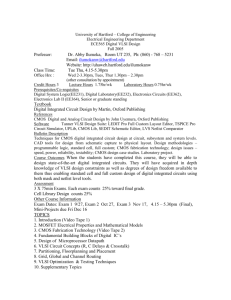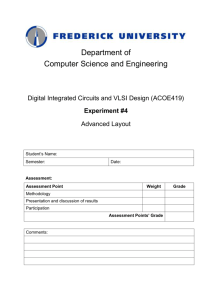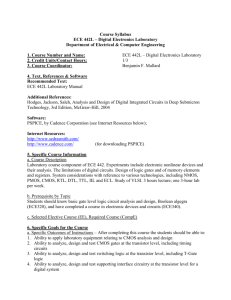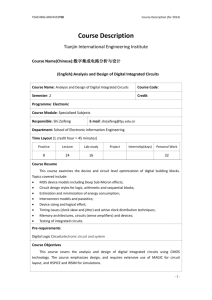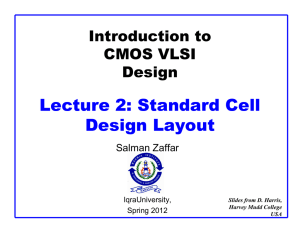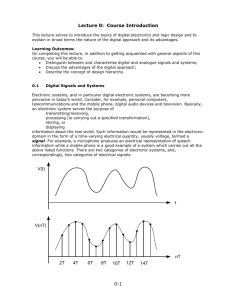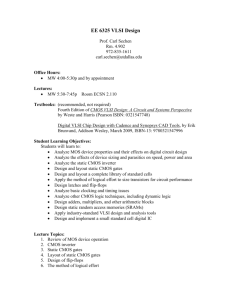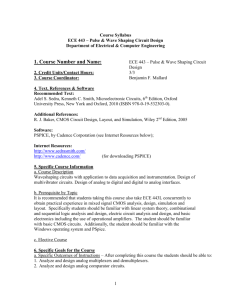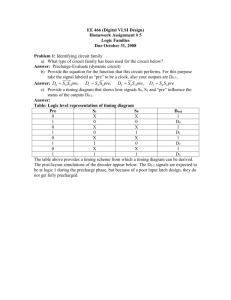Proposal . - University of Guelph
advertisement
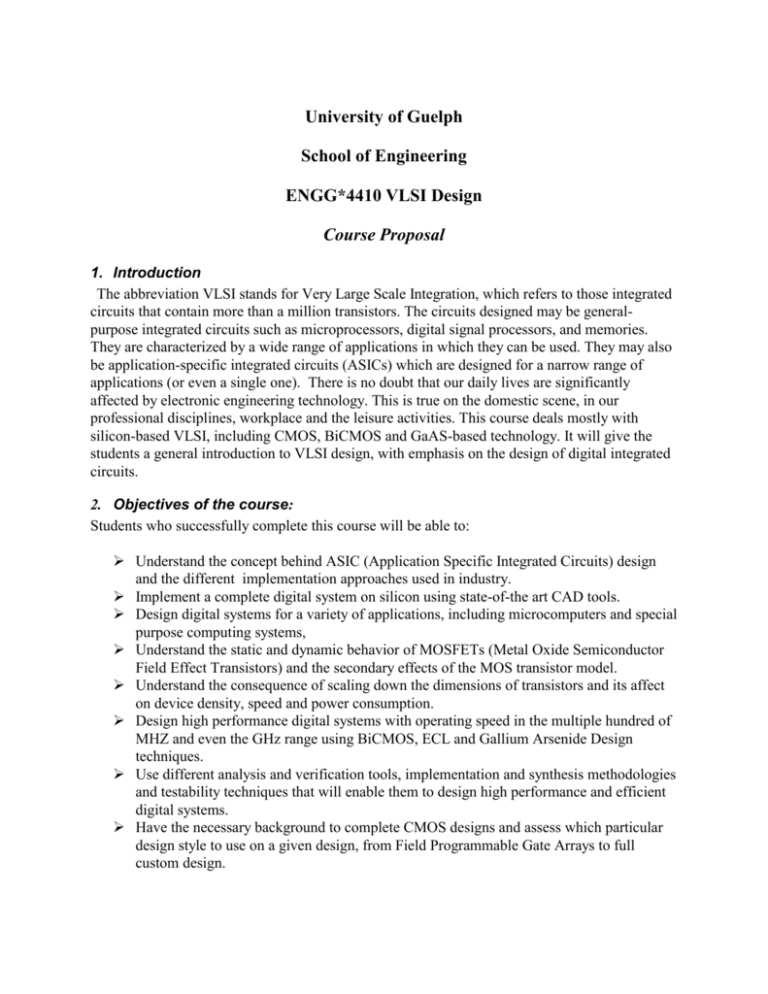
University of Guelph School of Engineering ENGG*4410 VLSI Design Course Proposal 1. Introduction The abbreviation VLSI stands for Very Large Scale Integration, which refers to those integrated circuits that contain more than a million transistors. The circuits designed may be generalpurpose integrated circuits such as microprocessors, digital signal processors, and memories. They are characterized by a wide range of applications in which they can be used. They may also be application-specific integrated circuits (ASICs) which are designed for a narrow range of applications (or even a single one). There is no doubt that our daily lives are significantly affected by electronic engineering technology. This is true on the domestic scene, in our professional disciplines, workplace and the leisure activities. This course deals mostly with silicon-based VLSI, including CMOS, BiCMOS and GaAS-based technology. It will give the students a general introduction to VLSI design, with emphasis on the design of digital integrated circuits. 2. Objectives of the course: Students who successfully complete this course will be able to: Understand the concept behind ASIC (Application Specific Integrated Circuits) design and the different implementation approaches used in industry. Implement a complete digital system on silicon using state-of-the art CAD tools. Design digital systems for a variety of applications, including microcomputers and special purpose computing systems, Understand the static and dynamic behavior of MOSFETs (Metal Oxide Semiconductor Field Effect Transistors) and the secondary effects of the MOS transistor model. Understand the consequence of scaling down the dimensions of transistors and its affect on device density, speed and power consumption. Design high performance digital systems with operating speed in the multiple hundred of MHZ and even the GHz range using BiCMOS, ECL and Gallium Arsenide Design techniques. Use different analysis and verification tools, implementation and synthesis methodologies and testability techniques that will enable them to design high performance and efficient digital systems. Have the necessary background to complete CMOS designs and assess which particular design style to use on a given design, from Field Programmable Gate Arrays to full custom design. 3. Material to be covered: After a historical overview of digital circuit design, the concepts of hierarchical design and the different abstraction layers are introduced. Starting from a model of the semiconductor devices, the course will gradually progress upwards covering the inverter, the complex logic gate (NAND, EXOR, Flip-FLOP), the functional (adder, multiplier, shifter, register) and the system module (data-path, controller, memory) levels of abstraction. For each of these layers, the dominant design parameters are identified and simplified models are constructed, abstracting away the nonessential details. Topics include: MOS transistors; CMOS logic; circuit representations; NMOS and PMOS transistor theory; CMOS processing technology; layout design rules; process parameterization; Circuit characterization and performance estimation; power consumption; CMOS logic structures; Clocking strategies; Data-path design; Programmable logic arrays; VLSI physical design; and system case studies such as a pixel graphic engine, 32 –bit CPU and self-routing switching networks. 4. Method of presentation: The course material will be presented in three hours of lecturing per week. There will also be a laboratory component. The laboratory will reinforce the subject material covered in the lectures, and will stress hardware issues (by implementing circuits of moderate complexity in Silicon). To mimic the real design process, the students will make extensive use of design tools such as circuit- and switch-level simulation as well as layout editing and extraction. Computer analysis is used throughout to verify manual results, to illustrate new concepts, or to examine complex behaviour beyond the reach of manual analysis. Laboratory: a) Introduction to Spice Simulation and Cadence Layout Design tools. b) Design and simulation of a Full adder using custom design and standard cell layout approach. c) A data-path arithmetic logic unit design. d) A finite state machine controller design. e) A project, which involves a circuit with more than 500 transistors that could be submitted for fabrication through CMC. 5. Method of evaluation: Assignments (3): 15% Laboratories (4): 20% Project (1): 15% Mid-term: 15% Final: 35% 6. Reason for course offering: The electronics industry has achieved a phenomenal growth over the last few decades, mainly due to the rapid advances in integration technologies and large-scale systems design. The use of integrated circuits in high-performance computing, telecommunications, and consumer electronics has been growing at a very fast pace. Typically, the required computational and information processing power of these applications is the driving force for the fast development of this field. The objective of this course is to help students develop in-depth analytical and design capabilities in digital CMOS circuits and chips. The development of VLSI chips requires an interdisciplinary team of architects, logic designers, circuit and layout designers, packaging engineers, test engineers, and process device engineers. Also essential are the computer aids for design automation and optimization. Thus, the ability to understand, analyze and design such systems has become an indispensable skill that ES&C engineers must have. With this skill they will be able to acquire more sustainable employment and help Canada become an even stronger competitor in the global marketplace, which is undergoing a fundamental transformation to knowledge-based industries. The proposed course seeks to provide the ES&C students with strong hardware design fundamentals suitable for either future graduate studies or for employment with computer-design companies. It will serve to provide the groundwork that the students require in the digital systems area. The laboratories and assignments will give the students genuine design experience, introducing them to the use of CAD tools for circuit design and full custom layout. 7. Resource needs: A. Cadence Design tools. B. Hspice Simulation Tools. C. Synopses synthesis and modeling design tools. D. Unix Operating System, C compiler, Perl programming. E. Powerfull workstations with at least 256 Mega Byte of Memory (SUN Ultra10 workstation with at least 512 Megabyte memory). 8. Library Assessment Currently the university library lacks resources, books and journals needed in this course. Some of the books mentioned are available locally at the University of Guelph and others are available at the University of Waterloo. The following library material is essential: Essential: Jan M. Rabaey, ‘Digital Integrated Circuits’, Prentice Hall, 1996, ISBN 0-13-178609-1. Neil Weste and Kamran Eshraghian, ‘Principles of CMOS VLSI Design’, Addison Wesley, 1991, ISBN 0-201-08222-5. Sung-Mo Kang, Yusuf Leblebici ‘CMOS Digital Integrated Circuits, Analysis and Design’, 2nd Edition, McGraw-Hill, 1999, ISBN 0-07-292507-8. R. Baker, H. Li and D. Boyce ‘CMOS Circuit Design, Layout and Simulation’, IEEE Press, 1998, ISBN 0-7803-3416-7. K. Roy, S. Prasad, ‘Low-Power CMOS VLSI Circuit Design’, Wiley, 2000, ISBN 0-47111488-X Supplementary: Sabih Gerez, ‘Algorithms for VLSI Design Automation’, Wiley, 1999, ISBN 0-47198489-2. Steven Rubin, ‘Computer Aids for VLSI Design’, Addison Wesley, 1987, ISBN 0-20105824-3. Sedra, Smith ‘Microelectronic Circuits’, 5th Edition, Oxford, 1998, ISBN 0-19-511690-9. A. Bellaouar, M. Elmasry ‘Low power Digital VLSI Design’, Kluwer, 1997, ISBN XXX. 9. Contributions to learning objectives: I. Literacy In-class discussions will stimulate students to express their perspectives on design techniques, trade-off issues, performance issues, and the societal impact of VLSI technology. The course assignments, project and laboratories will require the students to demonstrate their results in hardware and criticize other designs in terms of quality and performance tradeoffs. II. Numeracy The students will develop an ability to design complete systems based on sequential and combinatorial circuits. The students will use advanced CAD tools to implement their designs and verify them using simulation tools such as H-spice and Synopsis. The students will be required to fully understand why their designs function correctly from the fundamental principles including a mathematical derivation. III. Historical Development Arguably, invention of the transistor was a giant leap forward for low-power microelectronics that has remained unequaled to date, even by the virtual torrent of development it forbore. To reach their present level of sophistication they have gone through an opulent history of innovation and development, borrowing tools from other established knowledge domains. Part of this course will present important historical developments that have taken place in VLSI digital systems. IV. Global Understanding VLSI digital systems are being used in many applications such as communication, manufacturing, banking, medical, military, and hence they have the potential to impact our society in many aspects. Designing the multimillion transistor chips of today would be unthinkable without appropriate computer design tools. The students will be exposed to a variety of CAD tools and applications of digital systems and will be encouraged to identify and analyze their impact on such applications as well as on their societal impact. V. Moral Maturity Informed decisions in the design of digital systems are essential. The design of a VLSI digital system is a multi-stage decision process that is based on a body of consistent procedures of knowledge assimilation and critical judgement. It is typical that the design process will be challenged by conflicting criteria, and hence for students to apply the appropriate design procedures they will be required to exercise effective knowledge assimilation and moral maturity. VI. Aesthetic Maturity Students will be encouraged to strive for elegant designs. They will learn that elegance is not a property they seek in the final product only, but also in the procedures they use in the design process. Elegant designs make teamwork more efficient, enjoyable and highly rewarding experience. In this course students will experience how the design phases: analyze, design, evaluate are brought together in harmony to produce elegant systems. Aesthetic maturity is particularly important for this course, since digital systems are inherently complex and typically designed and implemented by more than one person. VII. Depth and Breadth of Understanding Topics covered in this course are interdisciplinary in terms of methodologies and application domains. For example, students will learn how design a complete digital system and optimize it in terms of cost and speed. They will also be introduced to simulation and modeling techniques that are used to design, and test digital systems. Moreover, basic understanding of electronic concepts that govern the behavior of Biploar Junction Transistors and Metal Oxide Silicon Transistors will be emphasized. VIII. Independence of Thought During class discussion students will be stimulated to express their views regarding existing VLSI digital systems and the pros and cons of the techniques used for implementing the system. They will also be motivated to exercise independence of thought in approaching the design exercises. IX. Love of Learning The students in this course will face many challenges that will stimulate their curiosity as to how the different components of a VLSI digital system are designed to work together in an orchestrated manner to achieve the desired behavior of the system. They will integrate knowledge from different domains to tackle problems of variant complexities. This will provide them with an excellent environment to enjoy learning through simulation and prototyping. Course Number Course Title (25 characters or less) Semester Offering S,F,W, Credit Weight (e.g. 0.5, 1.0) 0.5 05-441 VLSI Digital Design W Lecture Hours 3-2 and Lab Calendar Description This course introduces the students to the analysis, synthesis and design of Very Large Scale Integration digital circuits and implementing them in silicon. Topics include: Review of MOS transistor theory. MOS design equations; CMOS inverter characteristics and basic CMOS technology. CMOS processing technology and CMOS process enhancements. Layout design rules and process parameterization; Performance estimation; Switching characteristics and CMOS gate transistor sizing. Scaling of MOS transistor dimensions and interconnect layer scaling. CMOS logic gate design including Pass transistor logic, CMOS domino logic, Clocked CMOS logic and Pseudo nMOS logic. Design styles (Gate arrays, Standard Cell design and Full Custom Design). Custom design tools including: circuit level simulation; timing simulation; logic level simulation; schematic editors and design rule checkers. Physical design automation (partitioning, placement and routing). Clocking strategies and IO structures. Design strategies; Design capture and verification. CMOS testing principles. Department responsible for course: School of Engineering Indicate if applicable: Scheduling Instructions (annually or alternate years) Annually Prerequisite(s) ENGG*2450, ENGG*2410, ENGG*3450; or approval of instructor Corequisite(s) Concurrent Course(s) Exclusion(s) Course Outline: Week Number Topics To Be Covered #1 Introduction to CMOS Circuits and VLSI Design #2 MOS Design Equations and CMOS Inverter Characteristics #3 Basic CMOS Technology and Layout Design Rules #4 Performance Estimation Techniques and Switching Characteristics #5 CMOS Logic Gate Design, Dynamic and Static Logic Design #6 Chip Input and Output Circuits #7 Semiconductor Memories #8 Low Power CMOS Logic Circuits #9 BiCMOS Logic Circuits and High Performance Designs #10, #11 VLSI Design Methodologies #12 Design For Testability
